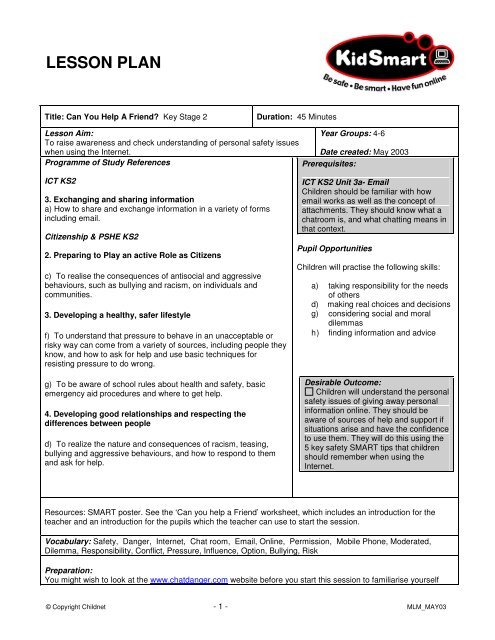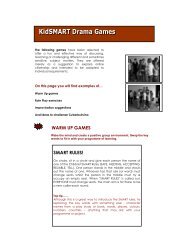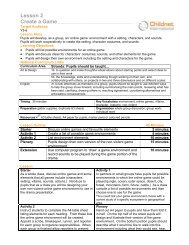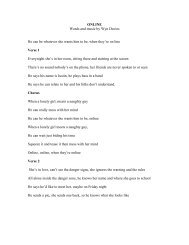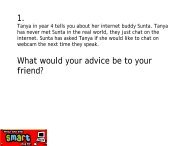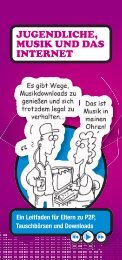Lesson plan - KS2 - Kidsmart
Lesson plan - KS2 - Kidsmart
Lesson plan - KS2 - Kidsmart
- No tags were found...
You also want an ePaper? Increase the reach of your titles
YUMPU automatically turns print PDFs into web optimized ePapers that Google loves.
LESSON PLANTitle: Can You Help A Friend? Key Stage 2Duration: 45 Minutes<strong>Lesson</strong> Aim:Year Groups: 4-6To raise awareness and check understanding of personal safety issueswhen using the Internet.Date created: May 2003Programme of Study ReferencesPrerequisites:ICT <strong>KS2</strong>3. Exchanging and sharing informationa) How to share and exchange information in a variety of formsincluding email.Citizenship & PSHE <strong>KS2</strong>2. Preparing to Play an active Role as Citizensc) To realise the consequences of antisocial and aggressivebehaviours, such as bullying and racism, on individuals andcommunities.3. Developing a healthy, safer lifestylef) To understand that pressure to behave in an unacceptable orrisky way can come from a variety of sources, including people theyknow, and how to ask for help and use basic techniques forresisting pressure to do wrong.g) To be aware of school rules about health and safety, basicemergency aid procedures and where to get help.4. Developing good relationships and respecting thedifferences between peopled) To realize the nature and consequences of racism, teasing,bullying and aggressive behaviours, and how to respond to themand ask for help.ICT <strong>KS2</strong> Unit 3a- EmailChildren should be familiar with howemail works as well as the concept ofattachments. They should know what achatroom is, and what chatting means inthat context.Pupil OpportunitiesChildren will practise the following skills:a) taking responsibility for the needsof othersd) making real choices and decisionsg) considering social and moraldilemmash) finding information and adviceDesirable Outcome:Children will understand the personalsafety issues of giving away personalinformation online. They should beaware of sources of help and support ifsituations arise and have the confidenceto use them. They will do this using the5 key safety SMART tips that childrenshould remember when using theInternet.Resources: SMART poster. See the ‘Can you help a Friend’ worksheet, which includes an introduction for theteacher and an introduction for the pupils which the teacher can use to start the session.Vocabulary: Safety, Danger, Internet, Chat room, Email, Online, Permission, Mobile Phone, Moderated,Dilemma, Responsibility, Conflict, Pressure, Influence, Option, Bullying, RiskPreparation:You might wish to look at the www.chatdanger.com website before you start this session to familiarise yourself© Copyright Childnet - 1 - MLM_MAY03
with how chat rooms work and what are the dangers. You should also explain that in school the Internet isgenerally filtered and supervised and so it is very unlikely that you would be contacted by someone that you didn’tknow. Explain sensitively, how this is different from out of school use, where more facilities such as Chat andInstant Messaging and Games link you up with potential strangers. Before introducing the activity, you may wish tohave an informal discussion with the children about their experience of chat rooms, email and computersgenerally. This will help you to pitch the lesson at the right level, and explain any terms which may be unfamiliar.For children who have never seen a chat room, you can visit a simulated version in our interactive guide StayingSmart Online. http://www.kidsmart.org.uk/guide.htm.Activity:This activity is based around a role play exercise. The pupils take on the role of a 10 year old girl called JessicaSamara. Jessica is a friend of Tiffany Walker also 10. Tiffany has moved away from the area and her father hasbought her a computer and a mobile telephone to enable her to keep in touch with her friends. Tiffany has hadseveral contacts in a chat room, by e-mail and text from a person she does not know. She is not sure how to dealwith this and keeps sending Jessica e-mails messages asking for advice. You can divide the children into groupsand give them each a message from Tiffany to respond to. You will need to photocopy the messages on theworksheet. Finally, the exercise looks at all the SMART rules and ends with the pupils having to remember theseand remind Tiffany of the safety advice in using the internet.Discussion Points:Discuss with the children whether they have used Chat rooms or ever been contacted via the Internet by someonethey don't really know. You might consider looking at the <strong>Kidsmart</strong> website with the children - especially theSMART rules at www.kidsmart.org.uk/smart.htm. You might want to discuss how people get hold of emailaddresses. (For example it is possible to guess someone’s address)Read to them the section on the actual activity sheet entitled "Introducing this lesson to your pupils" You might askif the pupils have friends in other parts of the country or overseas who they are in contact with by e-mail. The firstfew questions in the exercise ask the pupils what are the good things about being able to use the computer tokeep in touch with friends and are there any downsides (like not being able to hear their voice - an importantsafety issue !)Explain that together you will be working on this exercise with you handing the pupils the next message or readingthem out loud to the class. Explain that they are to imagine themselves as Jess and that they need to respond toTiff's questions. - You need to decide whether they do this on the worksheets by writing or by discussing in agroup and telling you audibly. If you choose the written reply consider allowing your pupils to use TXTabbreviations and language and emoticons (there is a separate worksheet on this).Extension Activities:1) The children could design a poster with the SMART message on it - see:www.childnet-int.org/kids/gallery.htmlfor examples. You could also do the SMART word search (see worksheet no 5 on the <strong>Kidsmart</strong> site.)http://www.kidsmart.org.uk/teachers-lesson.html2) Hand out to all pupils the <strong>Kidsmart</strong> leaflets (free from Childnet) for themselves and their parents asking thepupils to pass these on to their parents/carers.3) For more sophisticated children, you can find out how to trace a threatening email back to its origin by using theheaders. (See www. www.fkbko.co.uk)4) Consider asking Childnet to run a special Parent’s seminar in the school for interested parents/teachers.Conclusion: Recap the 5 rules and discuss the dangers of NOT following them.Differentiation: Those who have not had experience of using CHAT rooms should work with those who have.Assessment Opportunities:Are the children more aware of the dangers of using the Internet?Can the children relate the SMART rules they learnt through this exercise ?Can the children answer the 10 questions on the worksheet ?Can the children internalise the issues and remember to stay safe online when they are actually in a chat room orusing the Internet outside of the school.© Copyright Childnet - 2 - MLM_MAY03


